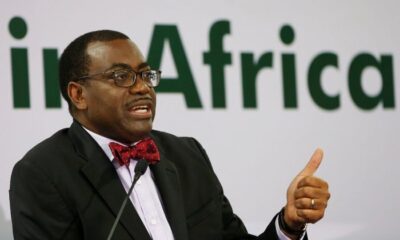Markets
Topmost Global Rating Body: Nigeria’s Economy Will Improve 2017
Published
8 years agoon

- Topmost Global Rating Body: Nigeria’s Economy Will Improve 2017
One of the world’s leading credit rating agencies, Moody’s, has cheerful news for Nigerians in 2017. It says the country’s economy and her dollar earnings are expected to improve in the new year.
The US-based top rating firm’s Vice President and Lead Analyst for Nigeria, Lucie Villa said Nigeria’s economy would bounce back to 2.5 percent in 2017 from its 1.5 per cent contraction in 2016.
Last July, the Minister of Finance, Kemi Adeosun, had said that Nigeria was “technically” in recession and that militant activities in the Niger Delta had affected government’s revenue. But Adeosun had also been upbeat about the chances of an economic improvement, saying, “We are going to come out of it and it would be a very short one because the policies that we have would ensure that we don’t go below where we need to go.”
The minister’s positive outlook was also echoed by Villa who said, “We expect Nigeria’s economic growth to bounce back to 2.5 percent in 2017, supported by an ongoing recovery in oil production.
“The government’s balance sheet is strong, with debt at around 16.6 per cent of Gross Domestic Product in 2016. Also, despite its interest burden rising to 19.8 per cent of revenue, Nigeria’s capital markets remain a reliable and captive source of liquidity and funding for the government.”
Villa’s optimistic outlook largely agreed with the projections in Moody’s latest report, released last December. In the report, which rates Nigeria’s economy B1 (stable), the agency noted that the “stable outlook” was supported by the strength of the country’s balance sheet. In 2017 and 2018, the credit rating agency said it expected Nigeria’s balance of payments to move back into surplus.
Moody’s, however, said Nigeria’s weak institutional framework, especially in terms of “the rule of law, government effectiveness and control of corruption,” would have a significant impact on its economic growth and fiscal strength, and thereby constrain the B1 rating.
“The country is still exposed to political risks arising from both the conflict with Boko Haram and recurrent attacks on oil infrastructures in the Niger Delta,” Villa added.
Moody’s also predicted that the Federal Government’s deficit would remain around two per cent in 2017 and 2018.
It said, “We forecast a general government budget deficit of three per cent of GDP in 2016, comprised of a two per cent of GDP Federal Government budget deficit and one per cent deficit split between state and municipal governments. We still assume that the authorities will not breach the statutory limit of three per cent imposed by the 2007 fiscal law, based on our view that they will reduce spending on a net basis if revenue collection underperforms.”
Moody’s stated further that two-thirds of 2017 real growth would come from the oil sector rebound alone, with a strong base effects expected in the second and third quarters.
“Nigeria’s large hydrocarbons reserves remain a key credit support: it has an estimated 37 billion barrels of oil (about 28 per cent of total African reserves) and nearly 34 billion of oil-equivalent in gas. Oil and gas exports tend to account for over 90 per cent of goods exports and a significant share of fiscal revenue (60-70% prior to the current oil shock). Our current oil price forecast are $45 per barrel in 2017 and $50 in 2018, compared to prices above $100 on average between 2010 and 2014,” Moody’s said.
Nigerian experts expressed similar views about the economy in 2017. According to the economists, the recovery will be slow, but if government increases productivity and implements the budget, Nigerians will have reasons to smile again.
An economist, Bismarck Rewane, said, “In terms of the economic outlook, it is going to be a very slow recovery towards the middle of the year, but it will be consistent and steady. So, we are likely going to see some improvements but (it would be) very slow. You would see that happening about the second quarter of 2017.
“There is hope as long as we are more productive (in 2017). The economic outlook can be considered positive as long as everyone contributes to the productivity of the country. It is a good thing that violence across the country is being curtailed. People can work under peaceful conditions, especially those who were displaced from their homes. There is hope because the Federal Government is demonstrating strong commitment to curb corruption.”
A former Head of Economics Department, Obafemi Awolowo University, Ile-Ife, Osun State, Prof. Abayomi Adebayo, also agreed with Rewane. According to him, Nigerians should be hopeful because the 2017 budget appears credible.
He said, “I believe there is hope because the budget appears to have credibility. There is hope because I believe this government will act appropriately and respond to active management of the economy to ensure sustainability and development.”
Similarly, an Associate Professor of Economics at the Ekiti State University, Abel Awe, said increased productivity would bring some cheer to the economy.
He said, “There is hope for the economy in 2017. With increased productivity, we can expect the recession to decline. The Federal Government should adequately address issues in the real sector, foreign exchange and encourage foreign investments.
“The economic outlook for 2017 will remain positive as long as the government and those directly involved in managing the economy pay proper attention to the key drivers of the economy,” he said.
However, other economic experts who spoke on the recession did not express as much optimism as Moody’s did.
They stated that there were many challenges the Federal Government must overcome before any ray of hope could be sighted on the horizon, adding that so far, the government and its economic handlers had not fully demonstrated the will and know-how to get the economy out of the woods.
A professor of Economics at the Olabisi Onabanjo University, Ago-Iwoye, Ogun State, Tella Sheriffdeen, said, “The current economic outlook of Nigeria is gloomy. There is nothing to cheer about it right now. If nothing is done to re-direct our economic path, we should expect harder times in 2017. The finance ministry and the Central Bank of Nigeria need to harmonise their contradicting policies to the extent that there will be liquidity in the system, which will enable people to borrow money and expand their businesses — there is the need to synchronise the fiscal and monetary policies.
“This also means that the Central Bank must bring down the interest rate. That expansion will increase goods output, which will consequently bring down the inflation rate in the country. There is the need for such alignment for the economy to move forward. Government has to do something about the exchange rate also. I have suggested to the Federal Government to change the colour of our currency’s higher denominations. This will make the naira to firm up again. India did that recently and it was successful.
The professor said more importantly, Nigeria needed to start producing goods, with the CBN encouraging credit.
He said, “Non-oil sector should be widened to include not only agriculture but other aspects of the economy. The 2017 budget must be passed on time before the end of the first quarter so that money for capital projects can be released as quickly as possible — that is something that can generate employment and promote production of goods in the New Year. Maybe, if all these are done properly, we will come out of the recession by the end of 2017. But if the central bank continues to tighten its monetary policy because of inflation, I don’t know what the result will be. Inflation is not caused by monetary policies alone. It is caused by the absence of goods in relation to demand by the people.”
To stimulate the economy further, he stated that the country’s capital market should encourage and appeal to organisations like telecommunication firms to list on the stock exchange.
According to him, having such companies listed gives credibility to the stock market which will in turn attract foreign investors.
However, the Director General of the West African Institute for Financial and Economic Management, Nigeria, Prof. Akpan Ekpo, offered hope but with a caveat.
He said, “If the government implements fully what it promised to do, around the third quarter of 2017, the recession might be abated. Therefore, 2017 still looks bleak. Unless the policies of the government, as contained in the 2017 budget, are effectively implemented, Nigerians will have to face the recession till the third or fourth quarter. To me, the economic outlook for 2017 is gloomy. But if they can implement the things they claimed they would do in the 2017 budget, we might start seeing some good signs in the economy next year (2017). Before then, the country has to continue to brace for hard times. There is no miracle against that.”
A Kaduna-based economist, Shadrack Madlion, painted a harsher picture, saying that government had failed to plan properly for the future.
He said, “2017 will prove that a man who fails to plan has planned to fail. In terms of agriculture, Nigerians are going to face hunger because we are right now in the dry season. No nation survives on rainfall-dependent agriculture — that is what we have focused on for many years. Now, the Federal Government made a pronouncement that the nation would plant and eat what it grows. But that is not supported with action.
“We have more SUVs (Sport Utility Vehicles) in Nigeria than farm tractors. We have arable lands to produce enough food to eat but $12bn is depleted on food importation (annually). So, the economic outlook for 2017 speaks for itself: Nigeria’s economic outlook for 2017 is bleak. There is no correlation between what government says and what it does.”
Responding to inquiry concerning the country’s 2017 economic outlook, the International Monetary Fund told our correspondent that the organisation’s country team for Nigeria would soon meet the Federal Government to deliberate on the economy and likely policy options.
It is only after the meeting, the global financial body stated, that it would be able to have informed responses as to whether Nigeria’s economic outlook for 2017 would be bright or bleak.
“As we have said before, Nigeria’s economy has been affected by a range of domestic and global developments, particularly lower oil receipts from the decline in both oil prices and oil production. The response to this requires an internally consistent and credible package of sustainable economic measures involving fiscal discipline, monetary tightening, banking sector strengthening, and structural reform.
“IMF staff are planning to conduct the annual Article IV discussions with the authorities during the first quarter of 2017. After that, we should have updated details on the authorities’ plans for economic recovery and the country’s economic outlook and growth plan for 2017,” a spokesperson for the IMF told our correspondent.
Is the CEO and Founder of Investors King Limited. He is a seasoned foreign exchange research analyst and a published author on Yahoo Finance, Business Insider, Nasdaq, Entrepreneur.com, Investorplace, and other prominent platforms. With over two decades of experience in global financial markets, Olukoya is well-recognized in the industry.

You may like
-
Nigeria Surpasses OPEC Quota with 1.51 Million bpd, Targets 2.06 Million in 2025
-
Global Investors Commit $7.6 Billion to Nigeria’s Development at AIF 2024
-
Nigeria-China Trade Strengthened as Grimaldi Introduces Direct Shipping Line
-
Nigeria’s GDP Records 3.46% Growth in Q3 Spurred by Non-Oil Sector
-
President Tinubu Presents N47.9trn 2025 Budget As Debt Servicing, Security, Infrastructure Take Lion Shares
-
I’m Not Nigeria’s PR, UK Party Leader, Kemi Badenoch, Tells Shettima













